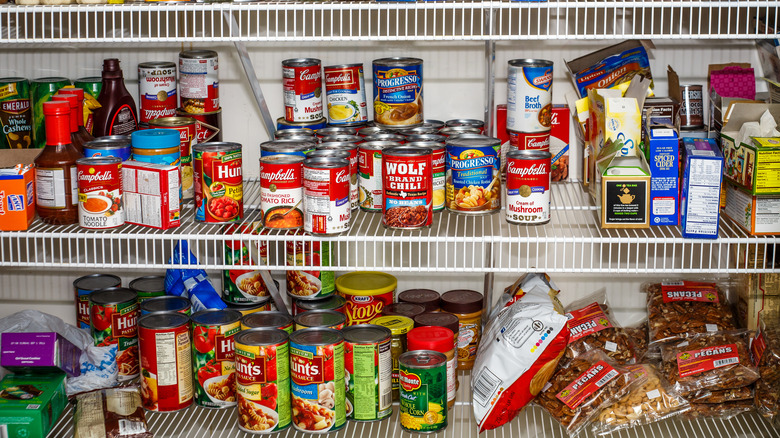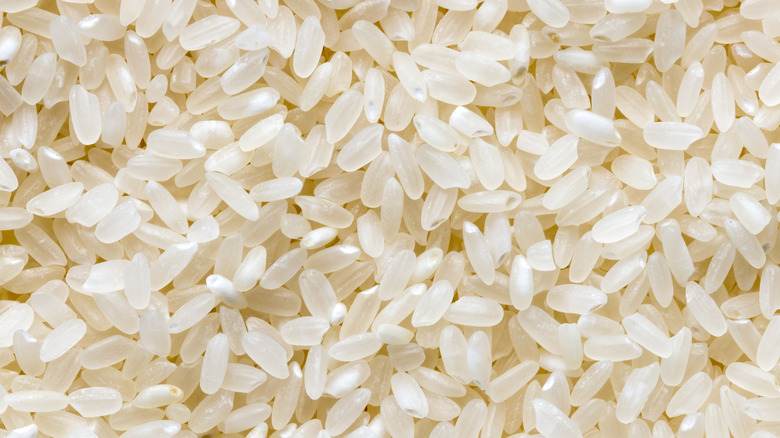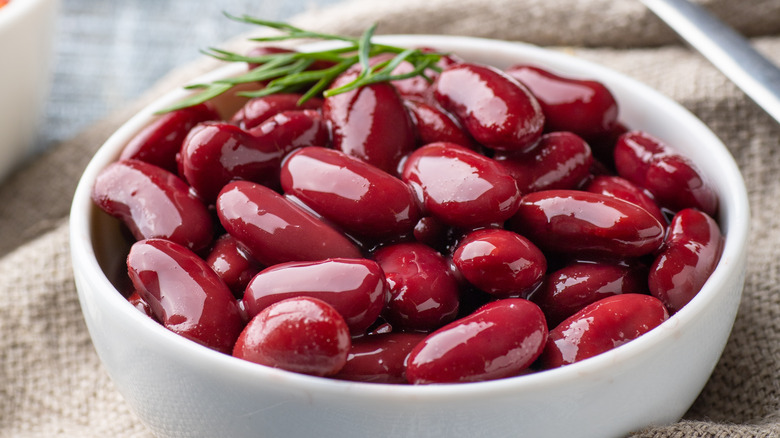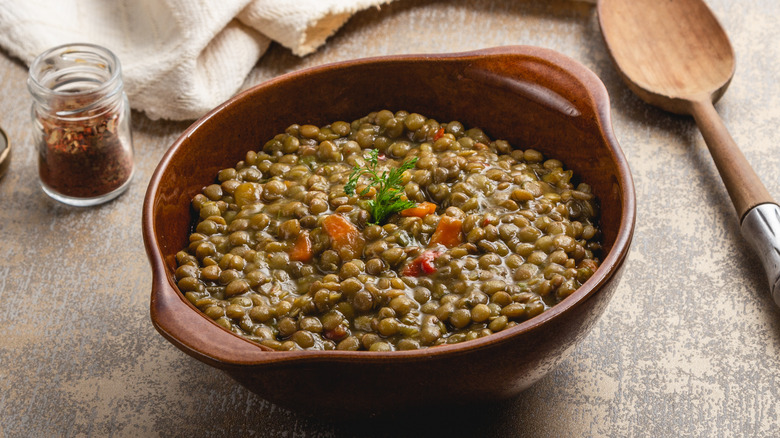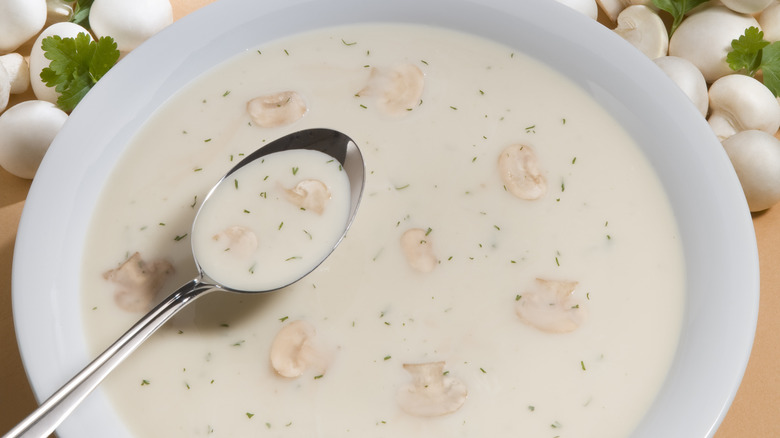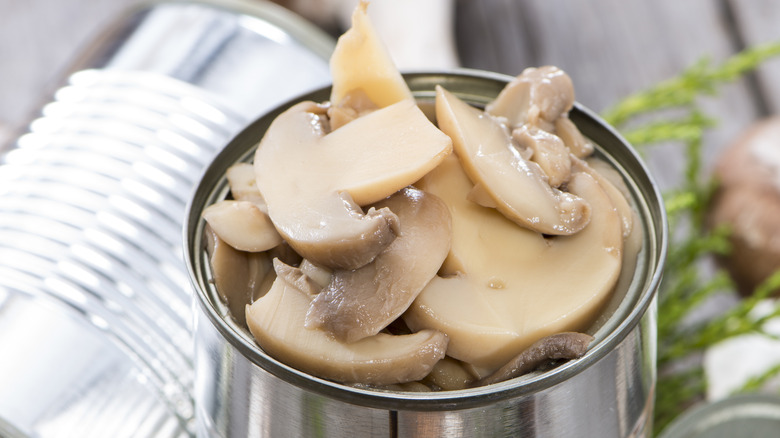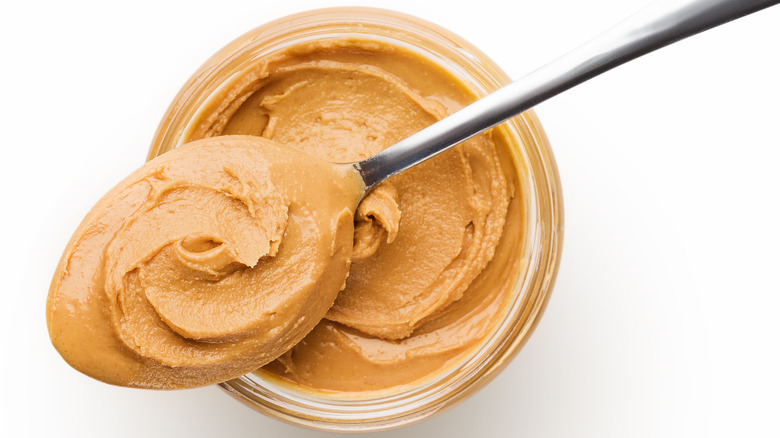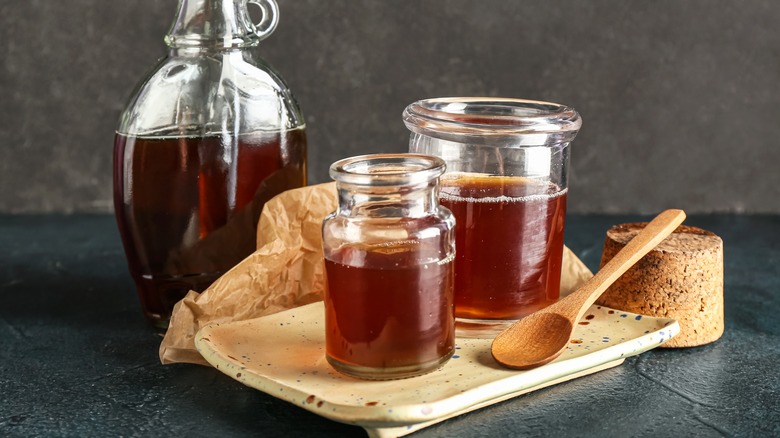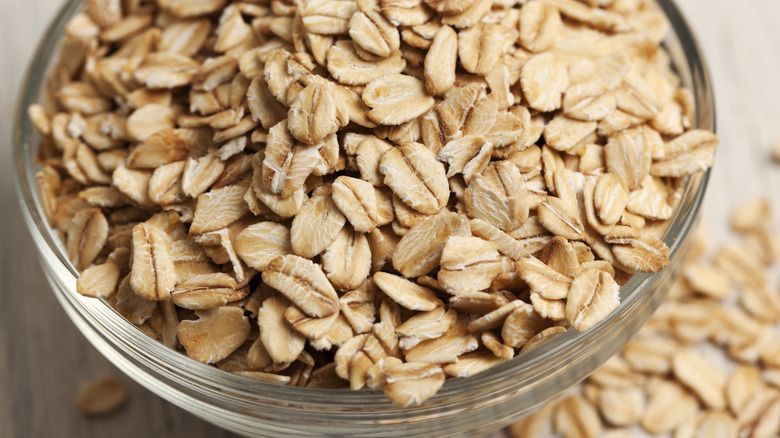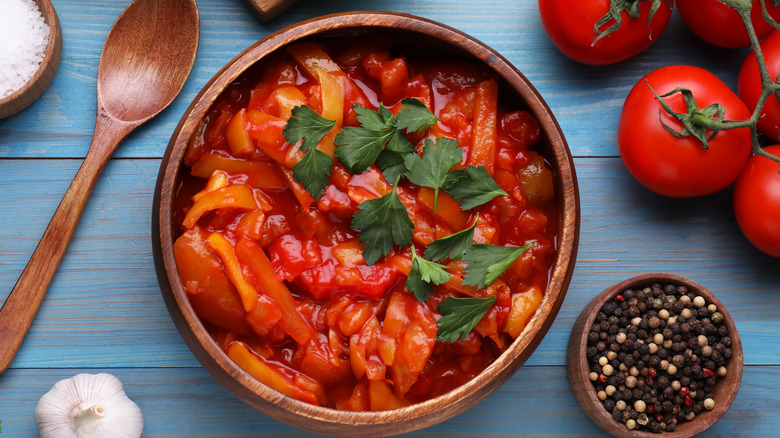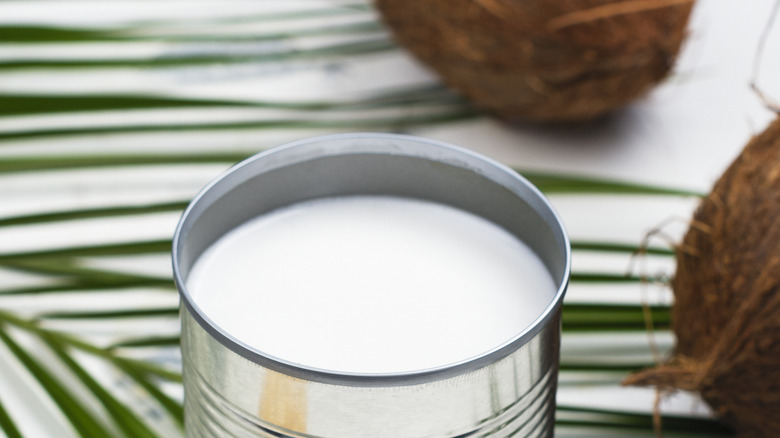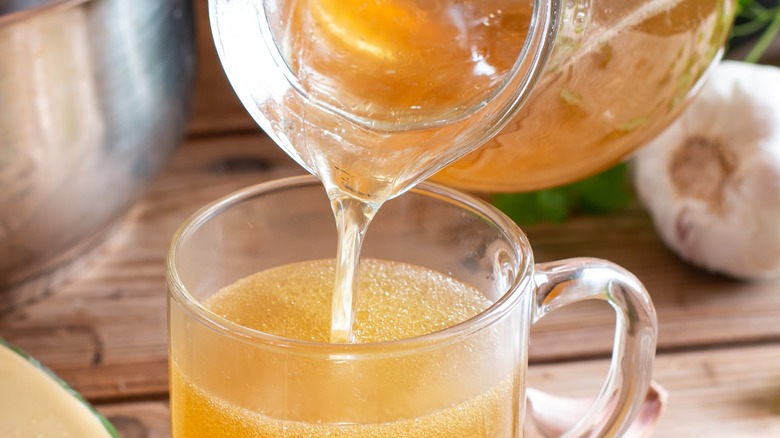11 Powerhouse Pantry Ingredients That Can Boost Any Dish
Pantries have been an essential part of the kitchen for centuries. In the olden days, when the term was first coined, the pantry was primarily a storage place for root veggies, jarred soups and jellies, cooking oil, flour, and sugar, and especially for bread. The "pan" at the start of the word even comes from the French name for bread, which is "pain," according to the Merriam-Webster Dictionary.
Flash-forward to the early 1900's and pantries also became the go-to spot to stash a growing number of canned and processed foods — all the fruits of the industrial revolution. Before long, pantries contained all the essentials we needed to make a meal, grab a snack, and always have something good on hand to eat. And in that way, little has changed in the last 100 years. Sure — the foods themselves that we buy in bulk might be different — but the idea remains the same. A well-stocked pantry should provide everything you need to make your favorite meals and to cook on the fly — basically ingredients that are incredibly versatile.
Is your pantry in need of a refresh? Here are 11 pantry-must haves — delicious essentials you can use in countless ways to build a meal or boost any dish you might have planned.
Stock up on microwaveable rice
Originally developed in the 2000s, bags of "instant" pre-cooked microwaveable rice were an immediate culinary game-changer. And even today, they're something every pantry needs. With dozens of varieties available — white rice, brown rice, Jasmine rice, chicken rice, Spanish rice, Pilaf rice and so much more — stocking up is smart. You can of course just nuke the rice and eat it as a plain side, but it can also be worked into countless entrees. Stir the warm rice into a shrimp or chicken stir-fry. Use it as a filling in tacos or burritos, or pour it into a bowl, and top it with salad greens, slices of cucumbers, grated carrots, avocado, and fresh tuna or salmon to make your own poke bowl.
Microwavable rice packets also make a great filling for any number of stuffed foods: stuffed bell peppers or tomatoes, acorn squash (pair the rice with sausage for an incredible treat), and even stuffed chicken breasts or chicken thighs. To make a DIY jambalaya with microwaveable rice, combine it with cooked sausage, shrimp, diced tomatoes, bell peppers, onions, Cajun seasoning, and a splash of chicken broth. Add everything to a large sauce pot, cover, and bring to a simmer until everything is heated through and the flavors are well combined. You can also pair microwaveable rice with eggs and veggies to make a hearty veggie frittata. Or make a Mediterranean salad with rice, cucumber, tomato, and fresh herbs and greens of your choice. Yum!
Stash some canned kidney beans in chili sauce
When it comes to canned beans, plain red kidney beans are fine. But, if you really want a pantry-expanding option that adds oomph and punch to countless dishes, then fill your shopping cart with a few cans of canned kidney beans in chili sauce. Made with a sauce combining tomatoes, chili powder, garlic, and cumin, these flavorful beans are of course ideal for use in chili con carne, bean dips, or as a filling for burritos or tacos. But, they're also a great option for so many other dishes as well.
You can pile them on nachos, chili cheese fries, or baked potatoes. Grilling burgers? Mash some of the beans and mix them into your beef for a unique flavor twist. Or just use the mashed kidney beans alone to make a vegan burger patty. You can also combine the kidney beans with corn, diced tomatoes, red onions, cilantro, and lime juice for a zesty Tex-Mex salad. For a more filling option, try layering cooked rice, kidney beans, diced vegetables, and cheese in a casserole dish and then bake until the cheese is bubbly and golden. It's an instant bean and rice casserole! The beans can also be added to stir-fries, poured into soups, and stews, and even used as a filling in homemade empanadas. Just fill the empanada dough with some of the beans. Add some grated cheese and spices and then bake until golden brown and crispy.
Lentils are useful nutritional powerhouse
The other legume every pantry needs is an abundant supply of canned lentils. But, don't worry — you'll be using them in completely different ways than you might use your canned kidney beans because lentils tend to have a more robust nutty, or peppery flavor. They're also incredibly good at absorbing other flavors, making them ideal for adding heartiness and volume to whatever you might be cooking. And, these creamy little nutritional powerhouses are also packed with protein, fiber, iron, folate, potassium, and other essential minerals and vitamins, making them an ideal way to make dishes healthier as well as better tasting.
Most people are familiar with lentils in soup and that's one of the easiest and best places to use them. You can add canned lentils to any vegetable stew, tomato soup, minestrone, coconut curry, kale, or chicken noodle soup you might be making. They'll blend perfectly into each, making them even more tasty and satisfying. Canned lentils can also be used in homemade hummus, tacos, stir-fries, wraps, fritters, or casseroles (like curried lentil pie). You can even mix them into green salads! Few things taste better or more refreshing on a hot day than a bowl of mixed greens, lentils, red onion, beets, cherry tomatoes, and the salad dressing of your choice. Delish!
Buy cream of mushroom soup in bulk
Even an art great like Andy Warhol recognized the value of canned soup. And, if you want a pantry filled with ingredients that can help to bolster almost any dish, you definitely need canned soup in the mix. For us, the greatest versatility — and the best overall bang for your buck — comes from canned cream of mushroom soup. It's got a powerful umami punch. It's creamy. It's savory. And, its uses are almost unlimited!
You can use cream of mushroom soup with cooked pasta and chicken for a weeknight dinner that's ready in no time. Pair it with egg noodles and sautéed chunks of steak for an instant beef stroganoff. Spoon the soup over chicken and top with cheese and spices for incredible baked mushroom chicken. Or, pour the soup on fresh or frozen burritos and top with cheese and enchilada sauce for an incredible 20-minute Mexican casserole.
Cream of mushroom soup isn't just for dinner either. It's also an excellent breakfast staple. To make a quick and easy mushroom and sausage breakfast casserole, layer cooked sausage, sautéed mushrooms, bread cubes, and cream of mushroom soup, and then bake until golden brown and set. The savory soup also makes an excellent base for a mushroom quiche and can even be used as a filling in mushroom and ham-stuffed crepes.
Canned mushrooms are a secret weapon
Hear us out: even if your pantry is filled with mushroom soup, you need to save some space for canned mushrooms as well. When it comes to pantry essentials, the truth is that you can never have too many mushrooms on hand! And, when you're looking to add a mild, earthy meat-like taste and texture to a dish, nothing is better than the convenience and affordability of canned mushrooms.
For starters, canned mushrooms can be used in almost any type of pasta dish. It doesn't matter if you're making a rich and hearty red sauce, a creamy Alfredo sauce, or even a basil and pesto-packed pesto, mushrooms work beautifully in all of these dishes, adding a subtle nutty and woody taste to each. Canned mushrooms can also be placed atop fresh or homemade pizzas and flatbreads, bruschetta, and even crostinis.
These little gems will also take a starring role in frittatas, homemade quiches, omelets, and even scrambled eggs. Whipping up a burger, sandwich, or grilled cheese? Don't forget to add a layer of canned mushrooms for an unexpected umami kick. And, if you're baking anything from a meat and veggie casserole to pot pies to stuffed chicken breasts, take a couple of minutes to pop open a can of mushrooms, drain and dice them, then add them to your recipe. They will add a complex, rich, and robust flavor and texture.
Peanut butter is more versatile than you think
Sure, peanut butter is great by the spoonful or piled high on a PB & J — with grape jelly of course! It also makes the very best cookies. But, peanut butter can also be an incredibly useful ingredient in a number of unexpected dishes, where it brings richness, saltiness, and of course that unique peanut goodness we all love so much!
Consider adding a dollop of peanut butter to the pot the next time you're making a curry or beef or pork stir-fry. You'll be amazed at what that extra bit of peanut flavor does to the dish. Or toss cooked udon noodles, ramen, or even regular egg noodles with a sauce made from a mixture of peanut butter, soy sauce, garlic, ginger, and a touch of honey or maple syrup. A scoop of peanut butter can also bring a unique must-try twist to chili!
For people following a plant-based diet, peanut butter can be an essential ingredient in a number of entrees you might whip up from your pantry. Try adding it to hummus: just blend peanut butter, chickpeas, lemon juice, garlic, and spices to a creamy consistency, and then grab some warm pitas. Or use peanut butter for an incredible vegetable glaze: Melt down a couple of tablespoons, stir in some soy sauce, honey, and a splash of sesame oil, and then use it to coat roasted or steamed vegetables — it's especially good with broccoli, carrots, sweet potatoes, and cauliflower!
Maple syrup on hand provides a touch of sweetness
This breakfast staple is good for more than use as a pancake or French toast topping. With its one-of-a-kind warm, smoky, buttery sweetness, maple syrup can also take a starring role in any number of savory main courses. For example, it's incredible brushed on salmon, ham, and pork chops as they cook. Add a dash of maple syrup to your favorite barbecue sauce to amp up its sweetness and complexity. You can also tenderize and flavor beef, pork, and chicken with a maple soy marinade before you throw them on the grill. Just combine maple syrup, soy sauce, garlic, and ginger, mix well, and let your meat marinate in the mixture for at least 30 minutes before you cook it.
Maple syrup also pairs beautifully with a wide variety of veggies. Toss roasted broccoli, cauliflower, green beans, or potatoes with a mixture of maple syrup, olive oil, and spices to amplify their delicious caramelized flavor. Whisk maple syrup with Dijon mustard, olive oil, and vinegar for a homemade maple mustard vinaigrette that works beautifully on any green salad. Add a dash of maple syrup to baked beans before you put them in the oven. Or drizzle a bit of maple syrup over Brussels sprouts, carrots, butternut, or acorn squash before you bake them for an incredibly sweet and smoky side dish that's steak house quality, but made right at home!
A good supply of oats goes a long way
If your knowledge of oats is limited to flavored packages of instant oatmeal, then make a deal with yourself to add a tub of whole raw oats (aka rolled oats or old-fashioned oats) to your next shopping list. It'll only set you back a couple of bucks, and the payoff could be life-changing. And, that's not hyperbole — research shows that people who eat oats often tend to live longer than people who don't. Raw oats can also have an incredible impact on your mealtime menu, adding depth and flavor to a wide variety of dishes.
For example, you can use oats in place of bread crumbs or crackers in meatballs and meatloaf, or even as a filling in stuffed peppers or mushrooms. You can also bread chicken and fish in ground oats before baking or pan-frying. Love risotto? Substitute oats for your Arborio rice for a creamy and nutritious twist on the classic dish. Or, for a lower-calorie and more savory twist on French fries or onion rings, try making veggie oat fritters. Just mix raw oats with grated vegetables, herbs, and spices plus an egg to bind everything together, and then bake or cook in your air fryer until golden brown and crispy. For a treat that falls somewhere between chips and a candy bar, try whipping up some oat energy bites. Just mix oats with nut butter, seeds, herbs, and spices, shape into balls, and refrigerate until set.
Spicy canned tomatoes are a must-have
Canned tomatoes are a given in most pantries. But, in addition to those regular diced tomatoes or perhaps a jar or two of tomato paste, you should always make sure you also have some tomatoes with a bit of heat on hand (such as Rotel diced tomatoes and green chilies).
These types of spicy canned tomatoes paired with some sort of chili or other fiery pepper are a quick and easy way to add flavor and heat to a wide variety of dishes. For instance, you can use these spicy tomatoes as a filling in quesadillas, tacos, and even cheese omelets. They can also serve as a ready-made enchilada sauce or a base for Sloppy Joes. For a quick and delicious tomato and pepper bruschetta chicken, spoon the canned tomatoes over cooked chicken breast, top with a bit of dried onion and basil spice and a handful of grated cheese, and then broil until the cheese is melted and bubbly.
You can also use spicy canned tomatoes for a homemade pasta sauce with a kick or as a base for the popular Middle Eastern dish known as shakshuka. Just brown some peppers, onions, and spice, add the tomatoes, and bring to a slow simmer. Then crack a few eggs into the dish and continue to simmer until the eggs have cooked. It's ideal for an impressive Sunday brunch — your guests will love it!
Every pantry needs some coconut milk
Coconut milk — the creamy, white liquid extracted from the flesh of mature coconuts — might not be something you cook with often. But it should be! A staple ingredient in many Southeast Asian, Indian, and Thai recipes, coconut milk is typically used to add a rich, creamy, slightly sweet taste and texture to curries and desserts. However, as a staple pantry ingredient, coconut milk can also be used in countless ways as a substitution or secret ingredient in almost anything you might be making.
For example, swap it as a dairy-free alternative to milk in smoothies, oatmeal, pancakes, or other baked items. You can also use it in place of cream in soups and sauces, or even in your morning cup of coffee or tea. Or, try coconut milk as a lower calorie substitute for sweetened condensed milk, as a base for soups, when making homemade ice cream, or even in mashed potatoes where it lends a unique tropical sweetness to the classic comfort food.
As a special "secret" ingredient to make some of your favorite dishes even tastier and more unique, try adding coconut milk to cooked rice or quinoa before serving. You can also whisk it into scrambled eggs, splash some into tomato soup, or pour it into marinades for meats or veggies you're prepping to grill.
Don't forget to stockpile some broth
Depending on your level of cooking skill or knowledge, chicken stock might be something you only buy a couple of times a year, especially around the holidays when every recipe seems to call for it. But surprise: Chicken stock is also an affordable, multi-functional ingredient that can be used in numerous ways to add flavor and pizzazz to almost anything you might be preparing.
For example, if you're making risotto or quinoa, try swapping chicken stock in place of water for added flavor and richness to your dish. Similarly, if you're making mashed potatoes, substitute some of the milk or cream in your dish for chicken stock for an even more savory and creamy treat. You can also use chicken stock instead of water when making gravy or pan sauces. It can even be a replacement for water when you're poaching chicken, fish, eggs, or vegetables. You'll still get the traditional moistness of a classically poached dish but with the added rich, umami qualities of the chicken stock infused into your entree.
Chicken stock is also a great addition to sauces, glazes, and marinades — just swap an equal amount in place of whatever water a recipe calls for. And, it can be used in addition to — or as a replacement for — butter when you are sautéing meats or veggies. More flavor, and less fat. Sounds like a winner to us! Let's dig in.

